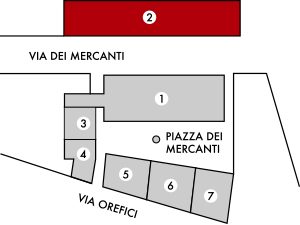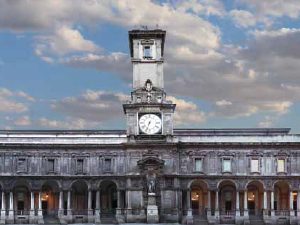Papa Pio IV, eletto nel 1559, apparteneva alla famiglia milanese dei Medici. Appena salito al soglio pontificio  decise di porre mano alla struttura architettonica di piazza Mercanti, stanziando una somma di denaro destinata al riadattamento dell’edificio posto a ridosso della medievale Torre di Napo Torriani, sede del Collegio dei Giureconsulti. Egli era infatti un quotato giurista e di questo Collegio, che raccoglieva i laureati in legge da cui si sceglievano anche i membri del Tribunale dei Giudici di Provvisione, aveva fatto parte. La progettazione dell’opera fu affidata a Vincenzo Seregni. I lavori iniziarono il 7 aprile 1562 e continuarono per quasi un secolo tra diatribe e rivendicazioni di luoghi e spazi. Per tutta l’età moderna il Palazzo fu la sede del Tribunale dei Giudici di Provvisione e del
decise di porre mano alla struttura architettonica di piazza Mercanti, stanziando una somma di denaro destinata al riadattamento dell’edificio posto a ridosso della medievale Torre di Napo Torriani, sede del Collegio dei Giureconsulti. Egli era infatti un quotato giurista e di questo Collegio, che raccoglieva i laureati in legge da cui si sceglievano anche i membri del Tribunale dei Giudici di Provvisione, aveva fatto parte. La progettazione dell’opera fu affidata a Vincenzo Seregni. I lavori iniziarono il 7 aprile 1562 e continuarono per quasi un secolo tra diatribe e rivendicazioni di luoghi e spazi. Per tutta l’età moderna il Palazzo fu la sede del Tribunale dei Giudici di Provvisione e del  Collegio dei Giureconsulti: all’interno ognuna delle due istituzioni aveva anche una propria Cappella religiosa. Dalla fine del ‘700 il Palazzo andò incontro a diversi utilizzi: da Ufficio di Conciliazione a Corte d’Appello, a luogo di depositi e magazzini, a sede della Borsa. Nel 1809 infatti la Camera di Commercio, volendo il Governo trasferire la neonata Borsa fino ad allora collocata al Monte di Pietà in luogo “a comodo dei negozianti … centrale ed ampio nella Piazza de’ Tribunali (ora via dei Mercanti)”, acquistò la grande sala usata per le udienze pubbliche dalla Corte d’Appello. Con l’esplodere delle attività di Borsa a metà ‘800 il portico di via Mercanti venne chiuso con vetrate per ampliare la sala ma pochi anni dopo, con l’abbattimento della Casa del Podestà e l’apertura di via Mercanti verso il Duomo, si dovettero affrontare nuovi lavori. La Borsa restò nel Palazzo fino al 1901 e, in questo lungo periodo, ebbe accanto locali affittati prima alla Cassa di risparmio (tre decenni dal 1823), poi alla Banca Popolare di Milano (dal 1870 al 1872). Nel 1877 il piano stradale venne abbassato per posare le rotaie del tram e al posto dell’antica Gabella del Sale arrivarono gli Uffici del telegrafo (1878). Il palazzo fu definitivamente venduto alla Camera di Commercio nel 1911 che lo ristrutturò una prima volta per portarvici i propri uffici; nel dopoguerra ne ricostruì una parte e infine lo restaurò, affidando i lavori a Gianni Mezzanotte (1989). Attualmente il Palazzo è proprietà della Camera di Commercio di Milano ed è utilizzato come luogo di rappresentanza e per l’organizzazione di eventi.
Collegio dei Giureconsulti: all’interno ognuna delle due istituzioni aveva anche una propria Cappella religiosa. Dalla fine del ‘700 il Palazzo andò incontro a diversi utilizzi: da Ufficio di Conciliazione a Corte d’Appello, a luogo di depositi e magazzini, a sede della Borsa. Nel 1809 infatti la Camera di Commercio, volendo il Governo trasferire la neonata Borsa fino ad allora collocata al Monte di Pietà in luogo “a comodo dei negozianti … centrale ed ampio nella Piazza de’ Tribunali (ora via dei Mercanti)”, acquistò la grande sala usata per le udienze pubbliche dalla Corte d’Appello. Con l’esplodere delle attività di Borsa a metà ‘800 il portico di via Mercanti venne chiuso con vetrate per ampliare la sala ma pochi anni dopo, con l’abbattimento della Casa del Podestà e l’apertura di via Mercanti verso il Duomo, si dovettero affrontare nuovi lavori. La Borsa restò nel Palazzo fino al 1901 e, in questo lungo periodo, ebbe accanto locali affittati prima alla Cassa di risparmio (tre decenni dal 1823), poi alla Banca Popolare di Milano (dal 1870 al 1872). Nel 1877 il piano stradale venne abbassato per posare le rotaie del tram e al posto dell’antica Gabella del Sale arrivarono gli Uffici del telegrafo (1878). Il palazzo fu definitivamente venduto alla Camera di Commercio nel 1911 che lo ristrutturò una prima volta per portarvici i propri uffici; nel dopoguerra ne ricostruì una parte e infine lo restaurò, affidando i lavori a Gianni Mezzanotte (1989). Attualmente il Palazzo è proprietà della Camera di Commercio di Milano ed è utilizzato come luogo di rappresentanza e per l’organizzazione di eventi.
Elected in 1559, Pope Pius IV belonged to the Milanese family of the Medici. As soon as he ascended to the papal  throne, he decided to reorganize the architectural structure of Piazza Mercanti, allocating funds for the modification of the building next to the medieval Torre di Napo Torriani where the Collegio dei Giureconsulti (College of the Jurisconsults) was located. A highly regarded jurist, he had been a member of this college, which comprised the law graduates from whom the members of the Tribunale dei Giudici di Provvisione (Court of Provision) were also chosen. Work on this project, for which the architect Vincenzo Seregni was responsible, started on 7 April 1562 and continued for almost a century despite numerous disagreements and claims on the use of various spaces. When completed, the palace housed the Tribunale dei Giudici di Provvisione and the Collegio dei Giureconsulti: both of these institutions had their own chapel in the same building. From the end of the eighteenth century the palace was used for different purposes: the conciliation office, the Court of Appeal, storerooms and warehouses and the premises of the stock exchange. In fact, because the government wished to move the newly-founded stock exchange, which hitherto had been located in the Monte di Pietà (the city’s institutional pawnbroker), to a place ‘convenient for tradespeople… central and spacious in the Piazza de’ Tribunali [now Via dei Mercanti]’, in 1809 the Chamber of Commerce purchased the large hall used for the public hearings of the Court of Appeal. When the activities of the stock exchange increased notably in the mid-nineteenth century, the loggia overlooking Via dei Mercanti was closed with large windows in order to expand the hall, but, a few years later, with the demolition of the Casa del Podestà and extension of Via dei Mercanti towards the cathedral, new work had to be undertaken. The stock exchange remained in the palace until 1901 and, during this long period, also availed itself of rooms rented, firstly to the Cassa di risparmio (for thirty years from 1823) and then to the Banca Popolare di Milano (1870 to 1872). In 1877 the level of the street was lowered for the laying of tramlines and, in 1878, the rooms of the old Gabella del Sale (salt-tax collectors) were replaced by telegraph offices. In 1911 the palace was purchased by the Chamber of Commerce, which, prior to moving its offices there, had it renovated; after the Second World War part of it was rebuilt and then had it restored by the architect Gianni Mezzanotte in 1989. At present the palace belongs to the Milan Chamber of Commerce and is used as a prestigious venue for conferences and other events.
throne, he decided to reorganize the architectural structure of Piazza Mercanti, allocating funds for the modification of the building next to the medieval Torre di Napo Torriani where the Collegio dei Giureconsulti (College of the Jurisconsults) was located. A highly regarded jurist, he had been a member of this college, which comprised the law graduates from whom the members of the Tribunale dei Giudici di Provvisione (Court of Provision) were also chosen. Work on this project, for which the architect Vincenzo Seregni was responsible, started on 7 April 1562 and continued for almost a century despite numerous disagreements and claims on the use of various spaces. When completed, the palace housed the Tribunale dei Giudici di Provvisione and the Collegio dei Giureconsulti: both of these institutions had their own chapel in the same building. From the end of the eighteenth century the palace was used for different purposes: the conciliation office, the Court of Appeal, storerooms and warehouses and the premises of the stock exchange. In fact, because the government wished to move the newly-founded stock exchange, which hitherto had been located in the Monte di Pietà (the city’s institutional pawnbroker), to a place ‘convenient for tradespeople… central and spacious in the Piazza de’ Tribunali [now Via dei Mercanti]’, in 1809 the Chamber of Commerce purchased the large hall used for the public hearings of the Court of Appeal. When the activities of the stock exchange increased notably in the mid-nineteenth century, the loggia overlooking Via dei Mercanti was closed with large windows in order to expand the hall, but, a few years later, with the demolition of the Casa del Podestà and extension of Via dei Mercanti towards the cathedral, new work had to be undertaken. The stock exchange remained in the palace until 1901 and, during this long period, also availed itself of rooms rented, firstly to the Cassa di risparmio (for thirty years from 1823) and then to the Banca Popolare di Milano (1870 to 1872). In 1877 the level of the street was lowered for the laying of tramlines and, in 1878, the rooms of the old Gabella del Sale (salt-tax collectors) were replaced by telegraph offices. In 1911 the palace was purchased by the Chamber of Commerce, which, prior to moving its offices there, had it renovated; after the Second World War part of it was rebuilt and then had it restored by the architect Gianni Mezzanotte in 1989. At present the palace belongs to the Milan Chamber of Commerce and is used as a prestigious venue for conferences and other events.